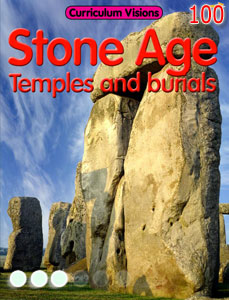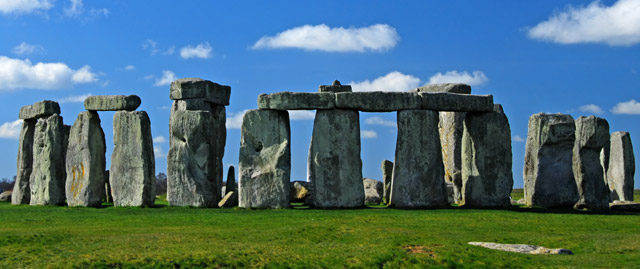Stonehenge is one of the most famous prehistoric sites in the world. In fact, the word ‘henge’ may come from an older word meaning gallows (medieval gallows had two uprights and a cross piece, like the trilithons of Stonehenge).
Its ditch and bank were probably dug about 5,100 years ago and the whole site given a face-lift several times, finishing with the giant trilithons which were added about 4,100 years ago (which is in Bronze Age time – after the end of the Stone Age). Notice that this is an enormous timespan. It is thought that maybe people even first put up three standing posts 6,500 years ago when the land was still wooded and before farming had begun.
The Stonehenge that we see today began when a circular bank and ditch 110 metres across was dug. By this time the surrounding land was farmed and the area was open grassland. The ditch was dug in sections, almost as though many groups of people were each made responsible for their own part of the ditch. Inside the ditch may have been a ring of standing timbers.
More standing timbers were put up about a century later. At this time the bank was made lower and the ditch partly filled in. At this time, too, the site was also used as a burial ground and many cremations took place. This makes it the earliest cremation cemetery in the British Isles.
About 4,600 years ago two sets of holes were dug and 80 standing stones, each 2 metres high and 1 metre wide and weighing 4 tonnes, were placed in them. A single large stone (now called the Altar Stone) was also placed at this time.
The north eastern entrance was widened to match the direction of the (then) midsummer sunrise and midwinter sunset. Four stones, known as Station Stones were also placed here, two of which are on mounds (known as barrows, but which do not contain burials). The Avenue, a pair of ditches and banks stretching 3 kilometres to the River Avon, was also dug at this time.
About 4,400 years ago 30 giant stones were brought from a nearby quarry and set up in a 33 metre circle with a ring of 30 lintel stones resting on top. Each standing stone was around 4 metres high, 2 metres wide and weighed around 25 tonnes. These were the first stones to be worked into shape, rather than being natural shapes. For example, the lintel stones curve slightly to continue the circular appearance of the earlier monument. However, the circle, if it was meant to be a circle, was never completed (it would have needed 74 stones). Finally, inside this circle, five trilithons (each of 2 uprights and 1 lintel, the biggest stones of all) were placed in a horseshoe-shape 14 metres across with its open end facing the entrance to the henge. The uprights weigh 50 tonnes.
All of this was finished by 4,100 years ago. Although many of the stones were moved at a later date, Stonehenge continued to be used until Iron Age times and the arrival of the Romans.






